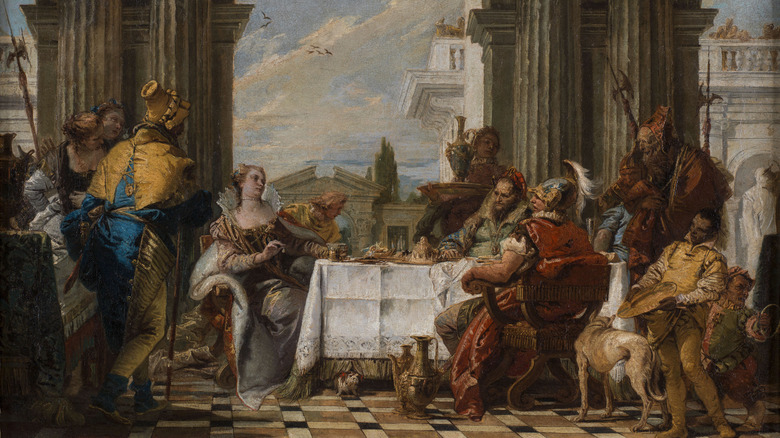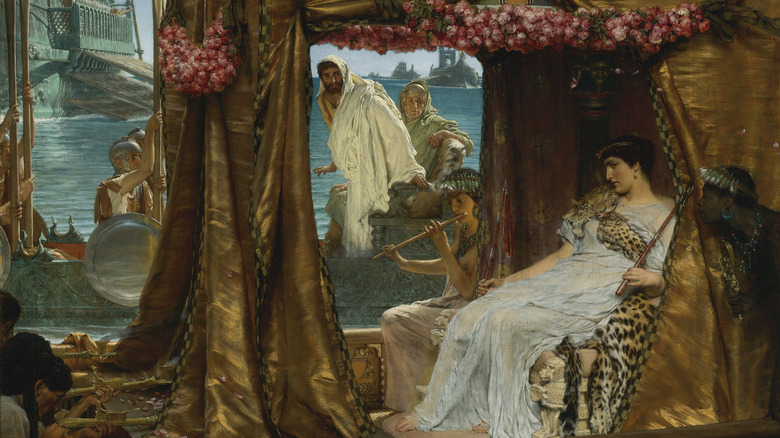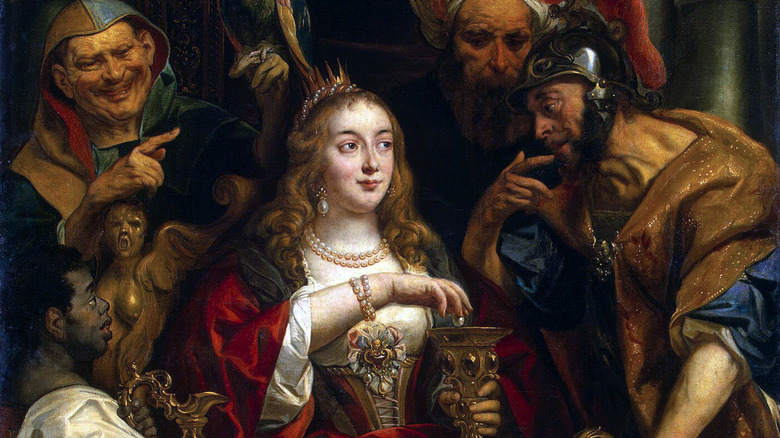What Was Actually Served At Cleopatra's Most Lavish Banquet
Roman general Mark Antony had one of the most legendary appetites of antiquity. For example, he once had eight wild boars roasted for a dinner party whose guest count was 12. An adult wild boar, for context, often weighs well over 300 pounds. Of course, Mark Antony also likely had fruits and spices served in abundance, as was the custom of the time (40 – 41 B.C.).
The most famous banquet Mark Antony ever attended, however, was one thrown by his lover, Egyptian queen Cleopatra. This lavish spectacle proved to be so memorable that it's still talked about over 2,000 years later. Antony devoured the first course in his usual fashion, and although Roman historian Pliny the Elder neglected to provide menu details in his "Natural History" — a landmark 37-volume tome published a little more than 100 years after the event — it was likely a mix of roast boar, figs, honey, and spices. But that's not important — it's the second course everyone remembers.
Cleopatra, famous for her grand gestures, had promised to spend $10 million sesterces — enough to pay the yearly salaries of 10,000 Roman legionaries — on a dinner for two. To do this, she dissolved one of her two pearl earrings in a glass of special vinegar and then proceeded to drink the remains. But these weren't just any pearls. According to Pliny the Elder, they were the largest pearls in existence at that time.
The background of Cleopatra's legendary banquet
Cleopatra, as the last queen and final Egyptian pharaoh, was ensured a measure of historical relevance. But her enduring fame so long after her death speaks to more than just her status as a powerful ancient ruler. It also speaks to her immense talent for grand gestures. For example, when ordered to appear before Roman general Mark Antony for the first time in 41 B.C., she staged an epic spectacle, sailing into Tarsus on a ship outfitted with golden accents and purple sails. Cleopatra herself assumed the garb of the Roman goddess of love, Venus, to meet the Roman delegation, and outfitted her attendants as cupids and nymphs.
Is it any wonder that Mark Antony fell in love with her, as Julius Caesar had before him? Cleopatra's seduction of Roman leaders at a time when Rome was in ascent, and was rapidly expanding its territory, almost certainly was strategic. But that still doesn't explain why, in the course of a lavish banquet, she would willingly destroy one of her most valuable possessions.
According to contemporary sources, Cleopatra's extravagant gesture was intended to show how little money mattered to her. This banquet, although the greatest of all in terms of cost, was but one of many luxurious banquets shared by Cleopatra and Mark Antony during the early days of their love affair when they wintered together in Alexandria, Egypt. Indeed, price seemed to be no object.
What ancient Romans and Egyptians typically ate
Consuming the world's most valuable pearl is lavish in any context, but in order to understand why this banquet is so famous, it helps to know what was normal at the time. The Egyptian diet of the era, for example, would probably have consisted of staples like beer and bread, as well as figs, olives, cheese, and assorted seafood and meats. The latter weren't meats that we would consider typical, like beef or chicken, but more commonly consisted of exotic game such as gazelle or hedgehog.
The ancient Roman diet was likewise a mix of the familiar — bread, wine, meat, and cheese — and the wholly unexpected. Much of what is now the Mediterranean diet was already in place, for example, but later Italian favorites like pasta and pizza had not yet been invented. Weird proteins like peacock and dormice were also in vogue, as were flamingos and ostriches.
The enormous wild boar Mark Antony was fond of consuming was extraordinarily extravagant, even by the standards of the time. In fact, Plutarch, in his "Lives of the Nobel Grecians and Romans," notes that Mark Antony was famous for his insatiable appetite for both food and drink. His extravagance, however, proved no match for that of Cleopatra, who was willing to squander a priceless gem for the sake of a good story.



